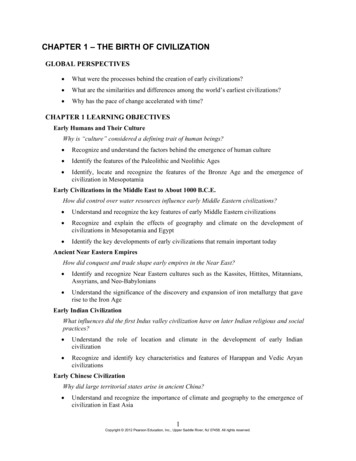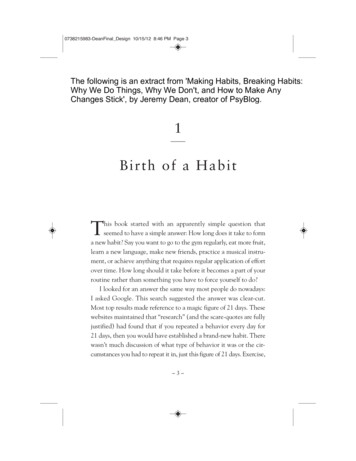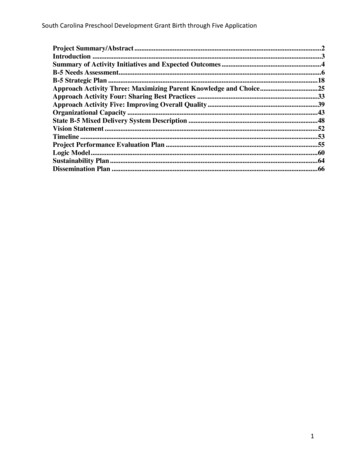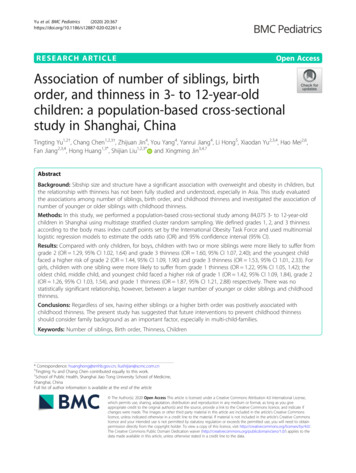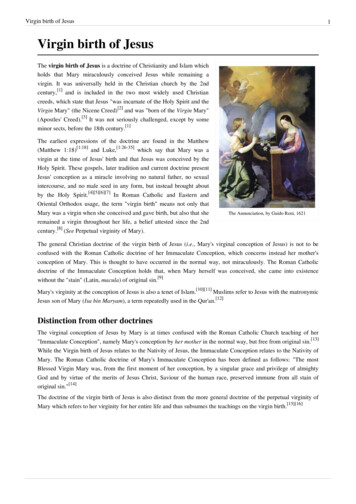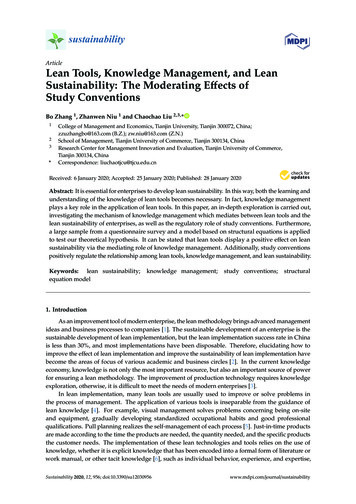
Transcription
TheBirthofLeanConversations with Taiichi Ohno, Eiji Toyoda, andother figures who shaped Toyota managementKoichi Shimokawa and Takahiro Fujimoto, EditorsTranslated by Brian Miller with John ShookThe Lean Enterprise InstituteCambridge, Massachussettslean.orgVersion 1.0March 2009
AcknowledgmentsNo part of this document may be reproduced, storedin a retrieval system, or transmitted in any formwithout the permission of Lean Enterprise Institute,Inc. To order copies or request permission toreproduce, please go to www.lean.org.The publisher expresses heartfelt gratitude to.Koichi Shimokawa and Takahiro Fujimoto, the editors of the original,Japanese edition of this book, for their cooperation in making thisEnglish-language edition possible;Kenichi Kuwashima, Takashi Matsuo, Nobuya Orihashi, Hiroaki Satake,and Yasuo Sugiyama for their contributions as interviewers and editorsin preparing the Japanese edition;Bunshindo, the publisher of the Japanese edition, for permission to publish this English-language edition; andDaihatsu Motor, Hashida Giken, the Toyota Commemorative Museum ofIndustry and Technology, and Toyota Motor Corporation for furnishingthe photographs that appear in this book, as detailed below:Daihatsu Motorpp. 22 (upper), 25, 28Hashida Giken Copyright 2009 Lean Enterprise Institute. All rights reserved.p. 22 (lower)Lean Enterprise Institute and the leaper image are registered trademarksToyota Commemorative Museum of Industry and Technologyof the Lean Enterprise Institute, Inc.pp. 3, 4, 5 (upper), 7, 12, 17, 78, 114, 137, 178, 227Toyota Motor CorporationISBN: 978-1-934109-22-9pp. 5 (lower), 6, 9, 26, 77, 103, 110, 112, 113, 115, 141, 144, 175, 218,Cover design by Lapisworks230, 242, 245, 251, 261March 2009The Lean Enterprise Institute, Inc.One Cambridge Center, Cambridge, MA 02142 USATel: 617-871-2900 Fax: 617-871-2999 lean.orgiii
20The Birth of Leanyour production line keeps moving as a result of kaizen, that’s great. Butkeeping the line moving should not be an end in itself. If work is exhausting and a worker gets fatigued, he should stop the line. That calls attention to the problem. Then, we can resolve the problem. Maybe by findinga better posture for the worker. Maybe by improving the job rotation.On the other hand, some kinds of work do not allow for stopping theline or even for varying the speed of the line. Painting is a good example.Those kinds of work call for other approaches to highlighting problemsChapter IIWhat I Learned fromTaiichi OhnoA talk by MichikazuTanakaAs recorded and edited by KoichiShimokawa andTakahiro Fujimoto with Kenichi Kuwashima andYasuo Sugiyamaand promoting kaizen.The Talk: Under the Guidance of Taiichi OhnoProfessor [Koichi] Shimokawa has asked me to describe for you my memories of Taiichi Ohno, the father of the kanban. I, like numerous others,owe a huge debt to Ohno-san. And since he has passed on, we wholearned from him have a responsibility to convey his teachings to the nextAbout the TextThe accompanying text is an adaptation of a talk delivered in January 1998by Michikazu Tanaka, a former executive of Daihatsu Motor. Tanaka gave thetalk to a study group convened under the auspices of the Japan TechnologyTransfer Association and chaired and cochaired by the compilers of this volume, Koichi Shimokawa and Takahiro Fujimoto. The study group comprisesautomotive production engineers and university researchers and has met regularly since 1991 to develop a vision for production systems in the automobileand automotive parts industries. The adaptation presented here reflects subsequent editing by Tanaka.21
22The Birth of LeanWhat I Learned from Taiichi Ohno23generation. I don’t know howhow reducing the amounts of parts alongside the assembly line or reduc-well I can fulfill that responsibil-ing the amounts of work-in-process between the processes would promoteity in the limited time availablekaizen. So I had viewed the parts and the work-in-process as somethinghere today. But I will try at leastof a disinterested observer.to describe Ohno-san’s basic ap-Ohno-san began appearing frequently at our Kyoto Plant in the earlyproach to kaizen, and I will offersome concrete examples.1970s. Daihatsu was preparing to handle some of the production of theDaihatsu’s headquarters and plant in Ikeda,Osaka, in the 1970sMy first encounter with Ohno-Toyota Publica there, and he was overseeing the introduction of the kanban system. I had no interest in kanban and had not paid any attention tosan was in 1967. Daihatsu had entered a strategic alliance with Toyotawhat Ohno-san was doing at the Kyoto Plant.that year, and Ohno-san visited our headquarters plant, in Ikeda. I was aShortly after the production of the Publica got under way in Kyoto,production manager there, and the first thing he said to me was, “You’vea fatal accident occurred at the plant. That threw the plant into chaos.got too many parts along the assembly line and too much work-in-processPeople were upset and didn’t know what to do. My boss at the Ikeda Plantbetween the processes. You can’t get any kaizen done in that mess.”called me over to his desk and told me that he wanted me to move to theI would hear that repeatedly during Ohno-san’s plant tour. But I was aKyoto Plant and get things back on an even keel.stubborn sort, and I was thinking all along that people have different waysI arrived in Kyoto a couple days after receiving the assignment. Whatof doing kaizen, that Ohno-san’s way was not the only way. I couldn’t seeI found there was appalling. All along the assembly line were mountainsAbout the SpeakerMichikazu Tanaka (center) describingthe principles of the Toyota Production System at the automotive tooling company Hashida Giken, whosepresident, Hiroshi Hashida, is seatedat the rightfour decades. He joined the company in 1949 and worked initially in equipMichikazu Tanaka spearheaded the trans-ment planning for plants and in plant management and production control.planting of the Toyota Production SystemTanaka rose to the rank of production manager at Daihatsu’s Ikeda (headquar-to Daihatsu, a manufacturer of mini ters) Plant, in the Osaka Prefecture city of Ikeda, and in 1973 moved to thevehicles. He began receiving guidanceKyoto Plant, which then specialized in producing passenger cars. He servedfrom Taiichi Ohno in 1967, the year thatas deputy plant manager and then plant manager in Kyoto before returningDaihatsu entered into a strategic allianceto headquarters in 1983 as a managing director responsible for production.with Toyota. And he demonstrated uncom-Named a senior managing director in June 1992, he retired from full-time workmon creativity and passion in adapting thelater that year.Toyota Production System to needs andcircumstances at his company.Born in Osaka in 1926, Tanaka workedin manufacturing at Daihatsu for more thanTanaka thus occupied center stage in the development of production technology at Daihatsu throughout his career. And he has remained active in retirement as an adviser to Daihatsu and as the chairman of a study group thatpromotes advances in surface processing at plants in Osaka Prefecture.
22The Birth of LeanWhat I Learned from Taiichi Ohno23generation. I don’t know howhow reducing the amounts of parts alongside the assembly line or reduc-well I can fulfill that responsibil-ing the amounts of work-in-process between the processes would promoteity in the limited time availablekaizen. So I had viewed the parts and the work-in-process as somethinghere today. But I will try at leastof a disinterested observer.to describe Ohno-san’s basic ap-Ohno-san began appearing frequently at our Kyoto Plant in the earlyproach to kaizen, and I will offersome concrete examples.1970s. Daihatsu was preparing to handle some of the production of theDaihatsu’s headquarters and plant in Ikeda,Osaka, in the 1970sMy first encounter with Ohno-Toyota Publica there, and he was overseeing the introduction of the kanban system. I had no interest in kanban and had not paid any attention tosan was in 1967. Daihatsu had entered a strategic alliance with Toyotawhat Ohno-san was doing at the Kyoto Plant.that year, and Ohno-san visited our headquarters plant, in Ikeda. I was aShortly after the production of the Publica got under way in Kyoto,production manager there, and the first thing he said to me was, “You’vea fatal accident occurred at the plant. That threw the plant into chaos.got too many parts along the assembly line and too much work-in-processPeople were upset and didn’t know what to do. My boss at the Ikeda Plantbetween the processes. You can’t get any kaizen done in that mess.”called me over to his desk and told me that he wanted me to move to theI would hear that repeatedly during Ohno-san’s plant tour. But I was aKyoto Plant and get things back on an even keel.stubborn sort, and I was thinking all along that people have different waysI arrived in Kyoto a couple days after receiving the assignment. Whatof doing kaizen, that Ohno-san’s way was not the only way. I couldn’t seeI found there was appalling. All along the assembly line were mountainsAbout the SpeakerMichikazu Tanaka (center) describingthe principles of the Toyota Production System at the automotive tooling company Hashida Giken, whosepresident, Hiroshi Hashida, is seatedat the rightfour decades. He joined the company in 1949 and worked initially in equipMichikazu Tanaka spearheaded the trans-ment planning for plants and in plant management and production control.planting of the Toyota Production SystemTanaka rose to the rank of production manager at Daihatsu’s Ikeda (headquar-to Daihatsu, a manufacturer of mini ters) Plant, in the Osaka Prefecture city of Ikeda, and in 1973 moved to thevehicles. He began receiving guidanceKyoto Plant, which then specialized in producing passenger cars. He servedfrom Taiichi Ohno in 1967, the year thatas deputy plant manager and then plant manager in Kyoto before returningDaihatsu entered into a strategic allianceto headquarters in 1983 as a managing director responsible for production.with Toyota. And he demonstrated uncom-Named a senior managing director in June 1992, he retired from full-time workmon creativity and passion in adapting thelater that year.Toyota Production System to needs andcircumstances at his company.Born in Osaka in 1926, Tanaka workedin manufacturing at Daihatsu for more thanTanaka thus occupied center stage in the development of production technology at Daihatsu throughout his career. And he has remained active in retirement as an adviser to Daihatsu and as the chairman of a study group thatpromotes advances in surface processing at plants in Osaka Prefecture.
24The Birth of LeanWhat I Learned from Taiichi Ohnoof parts. “Do you people think you’re working in a warehouse?!” was myhad yet to develop any interest ininitial greeting to my new colleagues.kanban. I simply observed theirWe were working hard on quality control activities at Daihatsu at thatefforts from a distance and tooktime, and I had thrown myself into those activities head over heels. Butpart as little as possible in thewhat I found at the Kyoto Plant gave me pause for thought. Posted all overendeavor.25the workplace were materials for administering the quality control effort.Toyota had developed aProducing and displaying the materials had become an end in itself. Wesomewhat upscale version ofneeded to get to work on more-substantive kaizen based on the actualthe Publica, the Publica Starlet,circumstances in the workplace. So I told everyone to get rid of any and allalso to be produced at our Kyotomaterials that didn’t provide concrete guidelines for how to go about ourPlant. The Starlet remained an ultracompact mass-market model. It car-work. We would retain only the materials that were obviously useful.ried an extremely low sticker price and would therefore be a low-marginThe Daihatsu Consorte of around 1970, a sistermodel to the Toyota Publicaundertaking, at best. Earning any kind of profit on the Starlet would deThanks but no thanksmand drastic cost cutting.We were producing a Daihatsu model closely related to the Publica, theThe production managers and group leaders at the Kyoto Plant wereConsorte, and we produced both models on the same line, using bodiesworking feverishly on installing the kanban system when I arrived. But Isupplied by Toyota. Our Consorte would remain in production, but theDaihatsu was and is the only automaker based in the Kansai region, centered on Osaka, Kyoto, and Kobe, and it boasts a history older than Toyota’s.fuel-efficient cars was soon to burgeon more dramatically than anyone couldhave guessed.But in the late 1960s, it was distinctly inferior to Toyota in product quality andDespite Daihatsu’s shortcomings, the company was posting annual growthin cost competitiveness. Joining the Toyota Group in 1967 presented Daihatsuin sales and earnings amid the booming growth in Japanese vehicle owner-with the pressing challenge of swiftly attaining Toyota-like standards in its die-ship. Toyota had therefore turned a blind eye to issues at its new affiliate. Butsel technology, in its vehicle technology, and in its production technology. Thatthe production team at Toyota took a closer look when it entrusted a Toyota-challenge became especially pressing in 1973, the year that Tanaka moved tobadged vehicle to Daihatsu. No less than Taiichi Ohno, then the executive vicethe Kyoto Plant.president for production at Toyota, took a personal interest in the project.Toyota was growing rapidly in the early 1970s, and its plants were unable toToyota had largely completed the task of adopting Ohno’s principles inkeep up with the surging demand in Japan, North America, and elsewhere forall its plants and processes, and it had accompanied those principles withthe company’s small, dependable models. In 1973, the automaker entrustedthe regimen of total quality control (TQC). In 1973, Toyota was in the midst ofsome of the production of its smallest model, the Publica, to Daihatsu’s Kyotopropagating the Toyota Production System and TQC at its principal suppliers.Plant. That was the fateful year of the first oil crisis, and demand for Toyota’sToyota suppliers in the Nagoya vicinity worked directly with Toyota plants and
24The Birth of LeanWhat I Learned from Taiichi Ohnoof parts. “Do you people think you’re working in a warehouse?!” was myhad yet to develop any interest ininitial greeting to my new colleagues.kanban. I simply observed theirWe were working hard on quality control activities at Daihatsu at thatefforts from a distance and tooktime, and I had thrown myself into those activities head over heels. Butpart as little as possible in thewhat I found at the Kyoto Plant gave me pause for thought. Posted all overendeavor.25the workplace were materials for administering the quality control effort.Toyota had developed aProducing and displaying the materials had become an end in itself. Wesomewhat upscale version ofneeded to get to work on more-substantive kaizen based on the actualthe Publica, the Publica Starlet,circumstances in the workplace. So I told everyone to get rid of any and allalso to be produced at our Kyotomaterials that didn’t provide concrete guidelines for how to go about ourPlant. The Starlet remained an ultracompact mass-market model. It car-work. We would retain only the materials that were obviously useful.ried an extremely low sticker price and would therefore be a low-marginThe Daihatsu Consorte of around 1970, a sistermodel to the Toyota Publicaundertaking, at best. Earning any kind of profit on the Starlet would deThanks but no thanksmand drastic cost cutting.We were producing a Daihatsu model closely related to the Publica, theThe production managers and group leaders at the Kyoto Plant wereConsorte, and we produced both models on the same line, using bodiesworking feverishly on installing the kanban system when I arrived. But Isupplied by Toyota. Our Consorte would remain in production, but theDaihatsu was and is the only automaker based in the Kansai region, centered on Osaka, Kyoto, and Kobe, and it boasts a history older than Toyota’s.fuel-efficient cars was soon to burgeon more dramatically than anyone couldhave guessed.But in the late 1960s, it was distinctly inferior to Toyota in product quality andDespite Daihatsu’s shortcomings, the company was posting annual growthin cost competitiveness. Joining the Toyota Group in 1967 presented Daihatsuin sales and earnings amid the booming growth in Japanese vehicle owner-with the pressing challenge of swiftly attaining Toyota-like standards in its die-ship. Toyota had therefore turned a blind eye to issues at its new affiliate. Butsel technology, in its vehicle technology, and in its production technology. Thatthe production team at Toyota took a closer look when it entrusted a Toyota-challenge became especially pressing in 1973, the year that Tanaka moved tobadged vehicle to Daihatsu. No less than Taiichi Ohno, then the executive vicethe Kyoto Plant.president for production at Toyota, took a personal interest in the project.Toyota was growing rapidly in the early 1970s, and its plants were unable toToyota had largely completed the task of adopting Ohno’s principles inkeep up with the surging demand in Japan, North America, and elsewhere forall its plants and processes, and it had accompanied those principles withthe company’s small, dependable models. In 1973, the automaker entrustedthe regimen of total quality control (TQC). In 1973, Toyota was in the midst ofsome of the production of its smallest model, the Publica, to Daihatsu’s Kyotopropagating the Toyota Production System and TQC at its principal suppliers.Plant. That was the fateful year of the first oil crisis, and demand for Toyota’sToyota suppliers in the Nagoya vicinity worked directly with Toyota plants and
26The Birth of LeanWhat I Learned from Taiichi OhnoStarlet would entail a lot moreimpossible, they contended, and we could not possibly assemble theparts than its predecessor. ThatStarlet without a new plant building. Sentiment mounted in the companywould mean producing two verythat we should refuse to accept the Toyota model.different models.Toyota’s Publica Starlet of 197327Junichi Ono, Daihatsu’s executive vice president for technology, cameThese days, automakers com-by my desk one day around that time and asked me for an opinion.monly produce two, three, or“Ohno-san says that we should make the new car without putting up aeven more models on the samenew building. Our production engineering people say that’s out of theassembly line. But in those days,question. What do you think?”each assembly line producedI replied in my typically irresponsible manner: “We might as well haveonly a single model. Our production team reviewed the proposal anda go at it. We don’t know what’s possible until we try. And if things don’tdetermined that we would need a 10,000-square-foot building to handlework out, we can always take it from there.” That was not to suggest thatthe new Toyota model.I was especially confident that we could produce the new model withoutOhno-san rejected our proposal out of hand. The Starlet, he insist-a new plant. And my boss was no more confident than I was. But weed, was an economy model. Building a new plant would raise the fixeddecided to tell Ohno-san that we would have a go. My boss and I went tocosts and render the project untenable from the outset. So much forToyota to deliver our response, but Ohno-san was out, so we simply leftToyota, scoffed our production engineering people. What’s impossible isa message: “We’ll do it without building a new plant.”had already begun to absorb the basic concepts. Daihatsu, however, had littlequestions remain about the applicability of the system in divergent corporatedaily interchange with Toyota, and introducing the Toyota Production Systemcultures and cultural milieu. Toyota’s experience in transferring the systemthere would be a unilateral undertaking. Ohno required an on-site evangelist,to Daihatsu is thus a hugely instructive episode. That episode is, indeed,and Tanaka was his man.the original blueprint for transplanting the system to new and unfamiliarWhat emerges from Tanaka’s talk is Ohno’s rigorous emphasis on (1) thegemba gembutsu (also genchi gembutsu) principle of focusing managementon the workplace and (2) eliciting wisdom and innovation from people in theworkplace. Ohno, we learn anew, was more interested in getting people tothink for themselves than in telling them what to do.People have understandably tended to focus on the technical aspects ofthe Toyota Production System. Tanaka reminds us of the crucial importanceof the human aspect of motivating people in the workplace through inspirational leadership. As famous as the Toyota Production System has become,environments.
26The Birth of LeanWhat I Learned from Taiichi OhnoStarlet would entail a lot moreimpossible, they contended, and we could not possibly assemble theparts than its predecessor. ThatStarlet without a new plant building. Sentiment mounted in the companywould mean producing two verythat we should refuse to accept the Toyota model.different models.Toyota’s Publica Starlet of 197327Junichi Ono, Daihatsu’s executive vice president for technology, cameThese days, automakers com-by my desk one day around that time and asked me for an opinion.monly produce two, three, or“Ohno-san says that we should make the new car without putting up aeven more models on the samenew building. Our production engineering people say that’s out of theassembly line. But in those days,question. What do you think?”each assembly line producedI replied in my typically irresponsible manner: “We might as well haveonly a single model. Our production team reviewed the proposal anda go at it. We don’t know what’s possible until we try. And if things don’tdetermined that we would need a 10,000-square-foot building to handlework out, we can always take it from there.” That was not to suggest thatthe new Toyota model.I was especially confident that we could produce the new model withoutOhno-san rejected our proposal out of hand. The Starlet, he insist-a new plant. And my boss was no more confident than I was. But weed, was an economy model. Building a new plant would raise the fixeddecided to tell Ohno-san that we would have a go. My boss and I went tocosts and render the project untenable from the outset. So much forToyota to deliver our response, but Ohno-san was out, so we simply leftToyota, scoffed our production engineering people. What’s impossible isa message: “We’ll do it without building a new plant.”had already begun to absorb the basic concepts. Daihatsu, however, had littlequestions remain about the applicability of the system in divergent corporatedaily interchange with Toyota, and introducing the Toyota Production Systemcultures and cultural milieu. Toyota’s experience in transferring the systemthere would be a unilateral undertaking. Ohno required an on-site evangelist,to Daihatsu is thus a hugely instructive episode. That episode is, indeed,and Tanaka was his man.the original blueprint for transplanting the system to new and unfamiliarWhat emerges from Tanaka’s talk is Ohno’s rigorous emphasis on (1) thegemba gembutsu (also genchi gembutsu) principle of focusing managementon the workplace and (2) eliciting wisdom and innovation from people in theworkplace. Ohno, we learn anew, was more interested in getting people tothink for themselves than in telling them what to do.People have understandably tended to focus on the technical aspects ofthe Toyota Production System. Tanaka reminds us of the crucial importanceof the human aspect of motivating people in the workplace through inspirational leadership. As famous as the Toyota Production System has become,environments.
28The Birth of LeanWhat I Learned from Taiichi Ohno29When I got back to the Kyoto Plant, the plant manager was away. Iacquiesce to a second plant building. I dispatched a defiant message totook the liberty of assembling the production managers and told them thatToyota: “Thanks but no thanks. We’ll get the job done with the facilitieswe had decided to produce the Starlet. They exploded and pummeled mewe have.”for about two hours with reasons that it was impossible. After listening tothe litany of impossibilities, I explained that I understood perfectly wellReady, set, go!why it was impossible but that we had decided to produce the Starletnonetheless. I told the managers that, henceforth, I was interested inOhno-san came around about once a month during the preparations forhearing about ways to produce the new model and that I had no moremass production. He always brought along a Toyota general manager frompatience for listening to why it was impossible. I called on them to joinproduction engineering by the name of Takemoto. I overheard him tellingme in figuring out how to make the new project work.Takemoto, “If this project doesn’t go right, you’re out of a job. And soThe years have mellowed me, but back then I was as pigheaded as theyam I.” Although Ohno-san was an executive vice president, I could tellcome. People knew that once I had made my mind up they would neverfrom the tone of his voice that he meant what he said. That inspired mepersuade me otherwise. The production managers were soon coming forthto work even harder to succeed.with ideas for achieving the necessary cost reductions. In one example,At a meeting one day, Ohno-san asked our president, Sakae Ohara,we were producing batches with a stamping machine that extended overwho his contact person should be for the Starlet project, and Ohara-san12 shifts, and we reduced the batch sizes to 6-shift lots. That halved thenamed me. I was sitting about three rows back, but they called me up tospace required to store in-process stampings, and we would be able tothe front of the room. That was exactly the fate that we all tried to avoid inuse the freed-up space to store parts for the second model. Everyone gotdealing with Ohno-san. Everyone was interested in hearing what he hadinto the act.to say, but no one wanted to face questions directly from the man whilePeople in every process found ways to save space over the next sixstanding at the front of a crowded room. That was because of Ohno-san’smonths. We carefully maintained the newly available space to have itmethod. If he had 10 things that he wanted to tell you, he’d tell you 2 andavailable when the time came to add a second production model. Whileexpect you to think for yourself until you came up with the other 8.Daihatsu’s Kyoto Plant around 1970we were working successfully toYou can imagine anyone’s terror at having Ohno-san look them in thefree up space, I heard througheye and ask, “What do you think?” I had yet to develop any interest inthe grapevine that Ohno-san hadthe kanban system, and I couldn’t help thinking that Ohara-san had delib-softened his stance. He had ap-erately named the manager least passionate about Ohno-san’s signatureparently told a subordinate to gotool.have a look at our Kyoto PlantThe day of the start of mass production finally arrived. I summonedand to let us know that, if abso-all the production managers for a meeting a little before 8 a.m. “Ohno-lutely necessary, Toyota mightsan is bound to show up before the week is out,” I cautioned them, “so
28The Birth of LeanWhat I Learned from Taiichi Ohno29When I got back to the Kyoto Plant, the plant manager was away. Iacquiesce to a second plant building. I dispatched a defiant message totook the liberty of assembling the production managers and told them thatToyota: “Thanks but no thanks. We’ll get the job done with the facilitieswe had decided to produce the Starlet. They exploded and pummeled mewe have.”for about two hours with reasons that it was impossible. After listening tothe litany of impossibilities, I explained that I understood perfectly wellReady, set, go!why it was impossible but that we had decided to produce the Starletnonetheless. I told the managers that, henceforth, I was interested inOhno-san came around about once a month during the preparations forhearing about ways to produce the new model and that I had no moremass production. He always brought along a Toyota general manager frompatience for listening to why it was impossible. I called on them to joinproduction engineering by the name of Takemoto. I overheard him tellingme in figuring out how to make the new project work.Takemoto, “If this project doesn’t go right, you’re out of a job. And soThe years have mellowed me, but back then I was as pigheaded as theyam I.” Although Ohno-san was an executive vice president, I could tellcome. People knew that once I had made my mind up they would neverfrom the tone of his voice that he meant what he said. That inspired mepersuade me otherwise. The production managers were soon coming forthto work even harder to succeed.with ideas for achieving the necessary cost reductions. In one example,At a meeting one day, Ohno-san asked our president, Sakae Ohara,we were producing batches with a stamping machine that extended overwho his contact person should be for the Starlet project, and Ohara-san12 shifts, and we reduced the batch sizes to 6-shift lots. That halved thenamed me. I was sitting about three rows back, but they called me up tospace required to store in-process stampings, and we would be able tothe front of the room. That was exactly the fate that we all tried to avoid inuse the freed-up space to store parts for the second model. Everyone gotdealing with Ohno-san. Everyone was interested in hearing what he hadinto the act.to say, but no one wanted to face questions directly from the man whilePeople in every process found ways to save space over the next sixstanding at the front of a crowded room. That was because of Ohno-san’smonths. We carefully maintained the newly available space to have itme
how reducing the amounts of parts alongside the assembly line or reduc-ing the amounts of work-in-process between the processes would promote kaizen. So I had viewed the parts and the work-in-process as something of a disinterested observer. Ohno-san began ap

